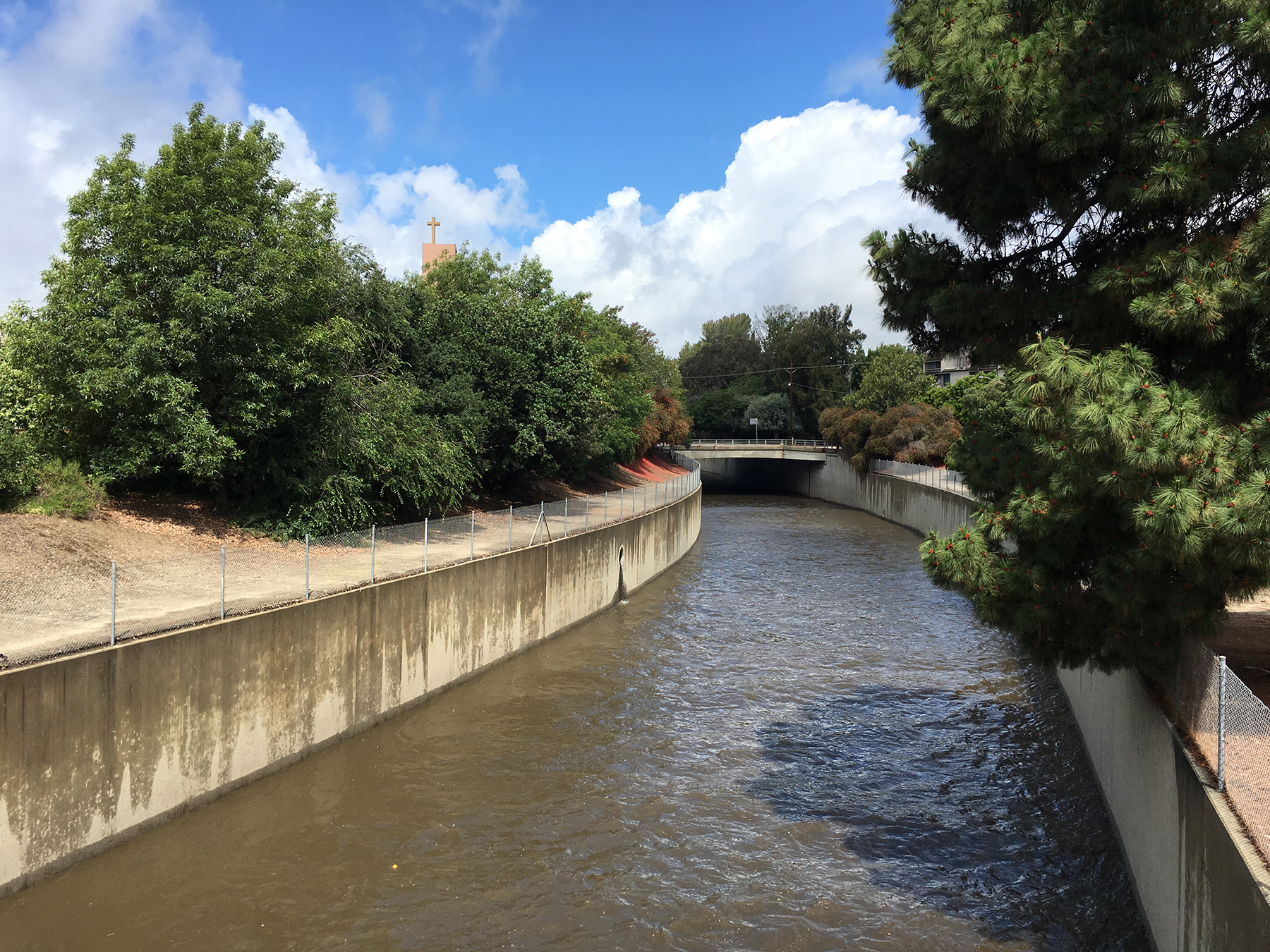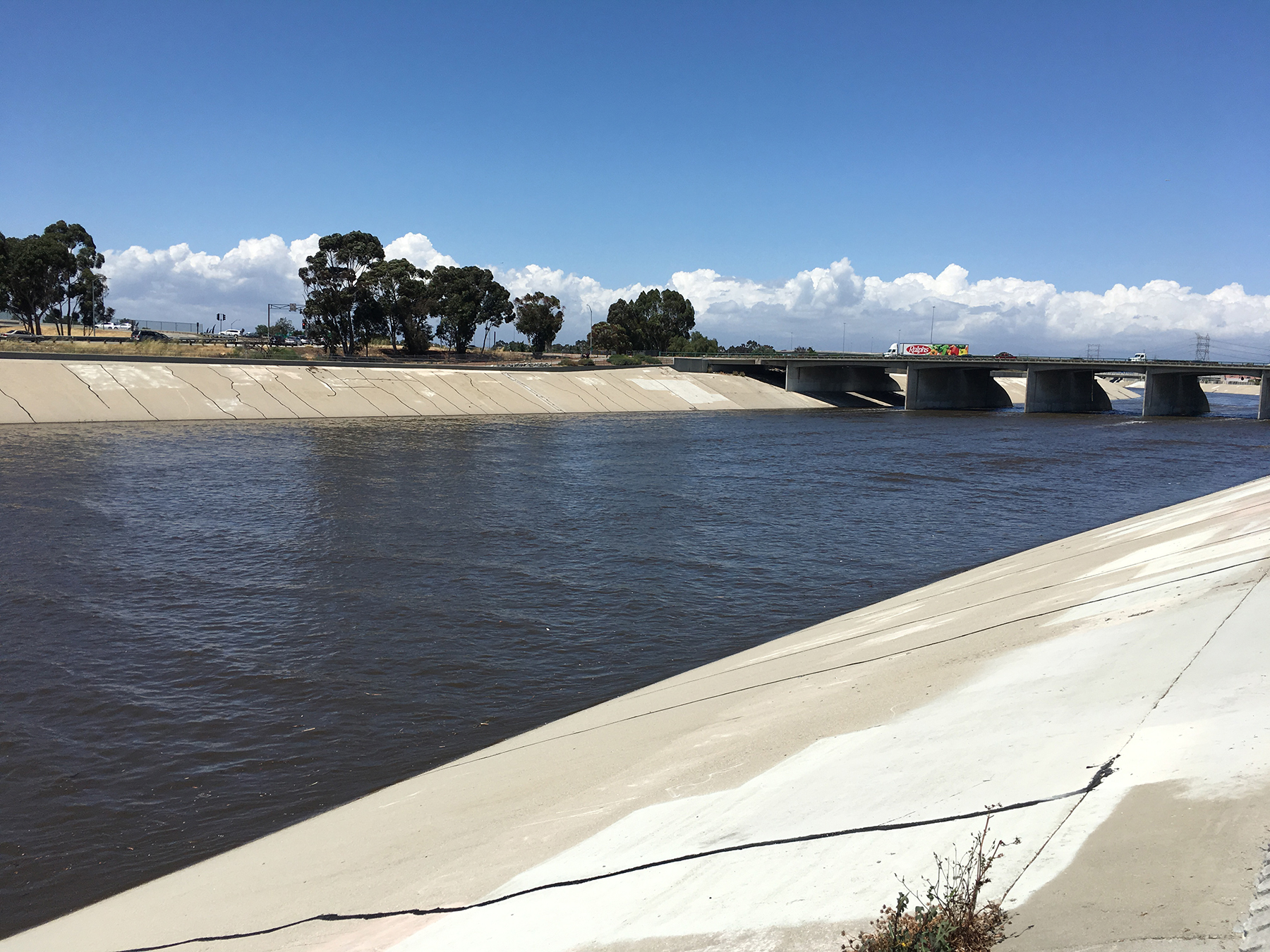By Jay Landers
With its Mediterranean climate, Los Angeles generally receives most of its annual rainfall during the winter months. During other times of the year, the city can go long periods without precipitation. As a result of this hydrologic regime, the Los Angeles River, during dry periods, can consist largely of treated effluent from the three wastewater treatment facilities that discharge to it: the Donald C. Tillman Water Reclamation Plant in the Los Angeles neighborhood of Van Nuys, the Los Angeles-Glendale Water Reclamation Plant in Los Angeles near its border with the city of Glendale, and the Burbank Water Reclamation Plant in Burbank.
Urban runoff also comprises a significant fraction of inflows to the river during dry weather.

As they seek to reduce their reliance on imported water supplies, the city of Los Angeles, Los Angeles County, and other local governments in the area are looking to increase the extent to which they engage in water reuse, a proven tactic for extending existing supplies in water-stressed regions.
As a means of improving water quality, some local agencies also plan to divert dry weather urban runoff from storm sewers to best management practices, such as detention ponds, infiltration basins, or rain gardens, or treatment facilities. Significant increases in reuse and dry weather diversions would decrease the volume of treated effluent and untreated runoff entering the heavily managed LA River, raising questions about potential effects on water quantity and quality.
Seeking to address the question of water quality, a team of researchers from the Colorado School of Mines and the Southern California Coastal Water Research Project, a public research and development agency, conducted modeling to quantify the effects that the practices likely would have on the loadings and concentrations of certain pollutants in the LA River.
Not surprisingly, decreased flows to the river were predicted to reduce daily pollutant loads, but daily concentrations of certain pollutants increased under different flow conditions, sometimes in excess of water quality objectives. The findings illustrate the potential complexities to be addressed as water stewards in semiarid and arid regions aim to manage water supplies in a more holistic fashion.
Different scenarios
For their study, the researchers used the Storm Water Management Model developed by the U.S. Environmental Protection Agency to model nine scenarios involving different degrees of water reuse and runoff diversion. For each scenario, the model predicted the resulting loads and concentrations within the LA River of the heavy metals copper, zinc, and lead as well as total suspended solids and total dissolved solids, referred to as TSS and TDS respectively. Above certain concentrations, all these can pose health threats to humans and wildlife.
The three heavy metals were chosen because their total maximum daily loads have been monitored extensively already for the LA River. (A TMDL involves a calculation to determine the maximum amount of a pollutant that may enter a waterbody while still enabling the waterbody to meet water quality standards for that pollutant.) The researchers on this project could then compare their findings with the previous findings to calibrate their model.
The modeling results appear in an article titled “Dilution and Pollution: Assessing the Impacts of Water Reuse and Flow Reduction on Water Quality in the Los Angeles River Basin,” which was published July 13 on the website of the journal ACS ES&T Water.
For the purposes of their model, the researchers established a range of baseline values for water quality parameters within wastewater, stormwater, and “nonstorm storm drain flows” entering the LA River. (Nonstorm storm drain flows refers to dry weather discharges to storm drains from such sources as irrigation, industrial discharges, and car washing.)
To simulate varying degrees of wastewater reuse, the researchers modeled water quality in the river under the conditions of 0%, 50%, and 100% reuse. (Reuse could be, for example, as irrigation). Zero percent reuse was equivalent to all treated wastewater entering the river, while 100% reuse meant no treated wastewater entered the river. Nonstorm storm drain flows were modeled under the same three conditions.
Loads versus concentrations
Because flow volumes decreased under all scenarios, the loads of all pollutants also decreased in each scenario, as would be expected. “Constituent loads are a function of flow,” says Victoria Hennon, EIT, one of the authors of the article who participated in the research as a master’s student at the Colorado School of Mines and is now a water resources engineer for the consulting firm Wright Water Engineers Inc. “When you decrease flow, (the constituents) are going to decrease in load.”
However, pollutant concentrations were a different matter. “That's where the results vary,” Hennon says. “Depending on the pollutant, you see concentrations increase even though you're decreasing flow in the river. That's due to dilution capacity and the sources of these pollutants.”
Increases in reuse and reductions in nonstorm storm drain flows were found to have “opposing effects on pollutant concentrations,” according to the article. Wastewater effluent tends to be low in TSS, lead, and copper concentrations, while dry weather runoff has higher concentrations of the pollutants. Meanwhile, decreased effluent volumes reduce the dilution effect that wastewater discharges have on nonstorm storm drain flows.
In simulations in which nonstorm storm drain flows were held constant under baseline conditions, increased reuse led to higher median concentrations of nearly all the pollutants. For example, increasing reuse by 50% resulted in a nearly 33% rise in TSS and a nearly 26% increase in lead concentrations. In a scenario in which all treated wastewater was reused, the concentrations grew even more pronounced, with TSS increasing by 101% and lead increasing by more than 80%. Increased reuse also led to higher TDS and copper concentrations, though not to the same extent as TSS and lead.
By contrast, when reuse was held constant under baseline conditions, reductions in nonstorm storm drain flows led to decreases in the median concentrations of the pollutants. For example, TSS and lead decreased by about 33% and 27%, respectively, when dry weather runoff was reduced by half. When dry weather runoff was reduced entirely, TSS and lead decreased by 98% and nearly 84%, respectively.

Among the pollutants, zinc was something of an outlier, as its concentrations increased slightly as dry weather runoff volumes decreased and reuse remained constant. For example, zinc concentrations rose nearly 2% when dry weather runoff was cut by 50%. Under conditions in which dry weather runoff was eliminated entirely, zinc concentrations increased by more than 5%.
Wet weather and noncompliance
Results for copper, zinc, and lead were compared with wet weather and dry weather limits set for the constituents within different reaches of the LA River under existing total maximum daily loads for the waterway.
In assessing regulatory compliance, the researchers determined the average annual percentage of the number of days during the wet season and the dry season that concentrations of copper, lead, and zinc complied with the pertinent TMDL limits.
During dry weather conditions, copper and lead remained in compliance approximately 99% of the time under all scenarios. Zinc does not have a compliance limit for dry weather periods.
During wet weather, copper and zinc declined in terms of their annual percent compliance under all scenarios. In part, this decline in performance can be attributed to the fact that pollutants present in stormwater runoff are not being diluted as much as they otherwise would have been because of the increased water reuse and reductions in nonstorm storm drain flows.
At baseline conditions, copper was in compliance 95% of the time. However, this declined to 85% when reuse was increased by 50% and nonstorm storm drain flows were reduced by 50%. Under a scenario of total water reuse and complete reduction of nonstorm storm drain flows, copper’s compliance fell to 59%.
Even under baseline conditions, zinc was found to be in compliance only 17.5% of the time during wet weather. This dipped to 15.4% when reuse was increased by 50% and nonstorm storm drain flows were reduced by 50%. Under a scenario of total water reuse and complete reduction of nonstorm storm drain flows, zinc’s compliance declined to 13.2%.
Unintended consequences
Although water reuse increasingly is a key component of efforts to extend water supplies in dry regions, the practice needs to be evaluated carefully in terms of how it can affect receiving waters, Hennon says. “We found that it could have some unintended consequences to the water quality and in some cases increase (pollutant) concentrations and actually not improve water quality compliance,” Hennon says.
Such effects can have implications for species that are sensitive to higher concentrations of certain pollutants, says Jordyn Wolfand, Ph.D., P.E., M.ASCE, an assistant professor of civil engineering at the University of Portland in Oregon and the lead author of the article who conducted research on the project while working as a postdoctoral research fellow and adjunct lecturer at the Colorado School of Mines.
“When you're looking at aquatic species, they're not seeing a load necessarily,” Wolfand says. “They're experiencing a concentration effect.”
Against this backdrop, the study results help illustrate that “there might be trade-offs in terms of water quantity and water quality,” Wolfand says. “We might see increased flows but actually worse water quality. We might see decreased flows but better water quality.”
Similar modeling efforts could be conducted on other urban rivers, provided they are effluent-dominated much like the LA River, says Eric Stein, Ph.D., the head of the biology department at the Southern California Coastal Water Research Project and another of the authors of the article. “The general approach, I think, is highly transferable,” he says. “It depends on how the wastewater is managed in the system.”
Ultimately, results from such studies can help water managers balance competing priorities, such as improving water quality and maintaining adequate flows to protect sensitive aquatic species in heavily managed river systems, Stein says.



